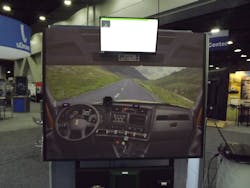Fatigued and drowsy driving technology from Seeing Machines makes its debut
CINCINNATI. An Australian-based company is trying its hand at the North American market with a new fatigue monitoring system. Seeing Machines is at the National Private Truck Council’s 2015 Annual Education Management Conference and Exhibition this week showing its new product, which includes eye-motion detection technology, in-cab warnings and dashboard reporting.
Originally developed close to 12 years ago in Australia, the technology has been utilized by fleets around the world to monitor and nearly eliminate distracted, drowsy and fatigued driving.
According to Erica Collins, general manager-fleet support, the system utilizes a sensor which monitors eye and face movement and determines whether those movements, such as frequently looking down or to one side, constitute a distracted driving event. Frequent and prolonged eyelid closure could also indicate a drowsy or fatigued situation, she said.
Once the system detects a potential problem, an in-cab audible alert is sounded (an optional vibration alert is available) and a notification is sent to a central call center located in Tucson, AZ. The call center personnel will notify the fleet within two minutes of a warning, allowing the fleet to take corrective action, such as ordering the driver off the road, if it believes there is a danger to the driver or others on the road.
The fleet could also dismiss the warning if it so chooses, Collins said. The only role Seeing Machines plays is in the notification process.
When combined with a fatigue management program, Collins said fleets have seen a significant drop in incidents.
“Unlike competitors’ passive recording technology that is used for post-event analysis and driver coaching, our technology assists operators and truck drivers in avoiding accidents in the first place. This has helped our customers reduce fatigue and distraction related incidents – helping keep people, cargo and equipment safe as well as increasing efficiency, productivity and profitability,” said Ken Kroeger, CEO, Seeing Machines.
According to the company, it spent more than 8 years testing the solution, which included case study work in mining, transportation and automotive with partners such as Caterpillar and Takata. The company has shipped more than 4,000 units worldwide and said users have reported a 71% drop in fatigue and distraction-related driving events.
Collins said the system will eventually be combined with a forward-facing camera to monitor the roadway, giving fleets even more data.
There is an optional configuration that will turn off cruise control if it is engaged and a fatigue event is detected.
